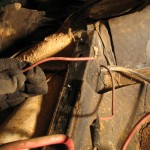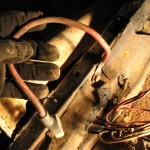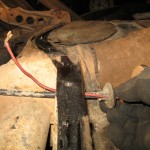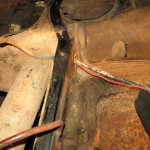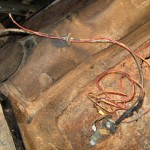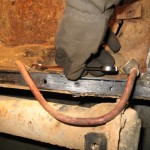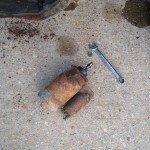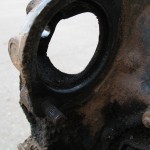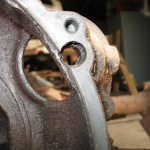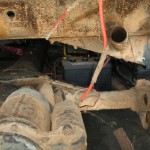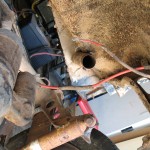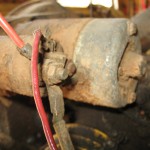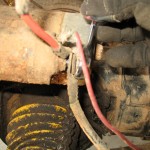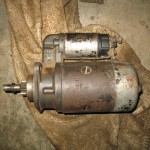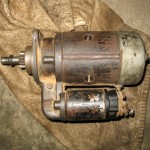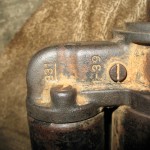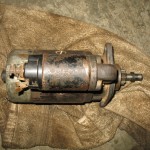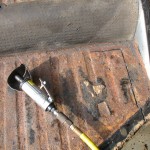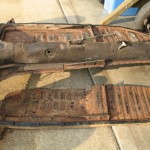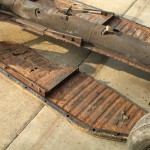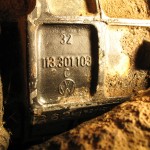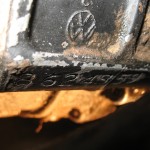Removed the battery- and starter cables, and removed the starter motor and solenoid.
DISASSEMBLY – Removing the floor pans
Today I started to cut out the pasenger-side floor pan. First, I made some measurements from the tunnel to the bolt holes alongside the outer edge of the pan, and from the support structures at either end of the pan to the first bolt holes on the side. This will hopefully allow me to double-check that the new pan is installed correctly, both front-to-back and from tunnel-to-side. If I cut the new pan, say, too short in the front, or if I install it too closely against the tunnel (or not close enough) then maybe I’ll have trouble lining up the bolt holes when I go to put the body back on. Or, the seats will not be in the right place, and might interfere with some other structure in the car. I think the pan would have to be off by more than an inch in either direction to cause problems, though, so some moderately accurate measurements should help me keep it close enough.
Transmission ID
Trying to identify the manufacture date or type of transmission takes a little work. You’d think the part number would do it (113 301 103 C), but it’s such a ubiquitous label for so many transmissions over so many years that you need to gather more information than that. Or, at least, I couldn’t find a list of part numbers that made it clear.
In addition to the part number, there is a serial number or stamping that can get you more information. On bugs built sometime after mine, the serial number is a date stamp. But it looks like mine is just a plain ole serial number (8624859).
Some people look inside the bottom of the transmission and actually count the number of gear teeth to find out exactly what they have. Reconstructing the history of a bug is a lot like archaeology. You dig and probe and re-evaluate what you know and what you think you know. It’s tempting to look at a crud-covered transmission and say that it’s the original transmission. But a lot can happen to a car over the 48 years of its life. Parts get replaced or swapped, or their internal gears and gadgets get upgraded or downgraded or whatever. Your transmission may be original, or it may have been swapped with a transmission from a ’61 VW (with its own family tree of parts) found in a junkyard in ’73. After a while the crud re-attaches, and everything gets normalized.
PARTS – Fasteners
New, stainless steel fasteners have arrived from England.
I wanted to upgrade the fasteners holding the chassis to the body, so I picked up a set from a gentleman on eBay (Member id: dcmotorsportuk). Some people sell these kits and include the rectangular mounting brackets, but I decided to keep my originals, and just clean them. The bolts could be cleaned too, I suppose, but some of the broke anyway when I was taking them out; I think the stainless will give me a longer-lasting, rust-resistant fastener.
Also, the engine tin bolts just seem to deform when you take them out. Straight-slot heads are tough when they get rusted. So I also picked up a set of engine tin fasteners from the same eBay seller.
